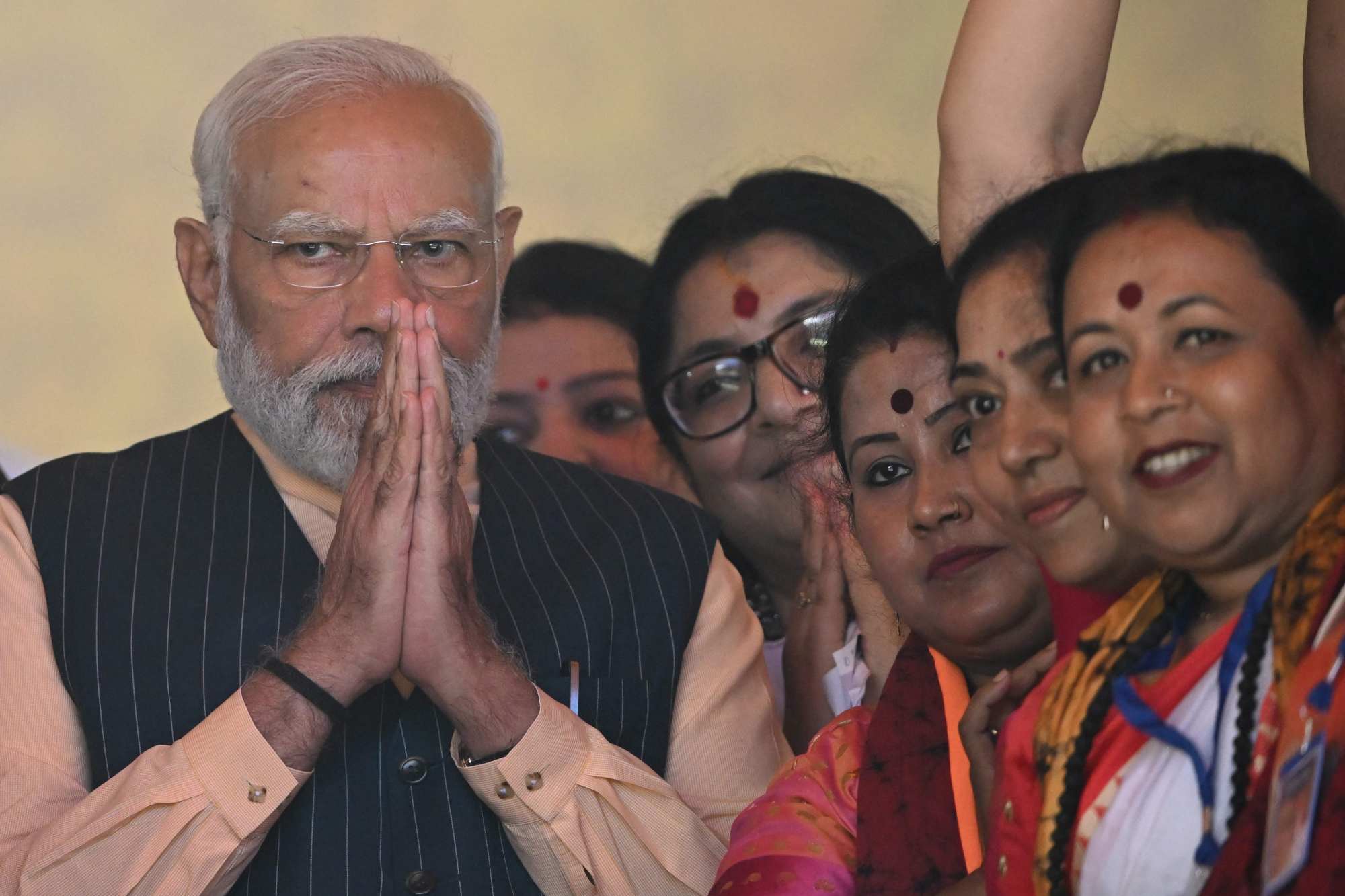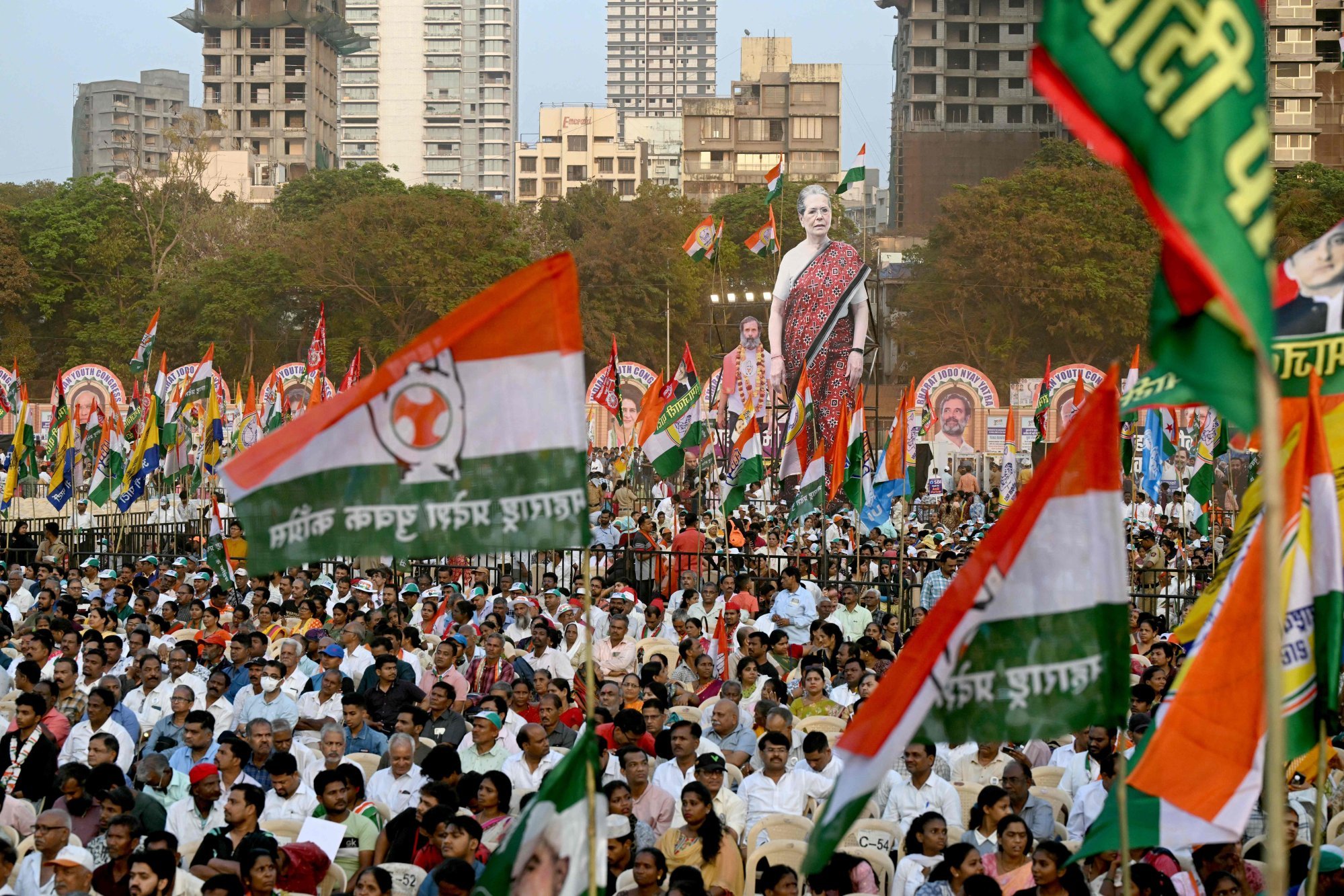
Will India’s long election season help Modi ‘create history’ – or throw up a last-minute surprise?
- India is holding a seven-phase vote, during which PM Modi will have time to pace himself at events and stretch the opposition’s limited resources
- Despite the opposition lacking a charismatic leader, analysts say their massive alliance would require the ruling BJP to win by bigger margins to maintain their majority
In the country’s second-longest voting exercise, 73-year-old Modi, the star campaigner of the ruling Bharatiya Janata Party (BJP) party, will have time to pace himself at events held amid the blazing summer heat as well as stretch the opposition’s comparatively limited resources.
But observers believe the polls in the world’s biggest democracy are still likely to be a close fight, rather than a cakewalk, for the BJP. Despite the opposition bloc lacking a charismatic leader who can take Modi head on, analysts said their strategic alliance-building would mean the ruling party may find it tough to maintain the majority it secured in the last elections.
“Ab ke baar 400 paar”, or “We will create history with a 400-seat victory”, is the slogan upbeat BJP workers have been chanting at rallies recently, optimism fuelled by opinion polls showing Modi’s popularity remains undimmed after two consecutive five-year terms in office.

The BJP won 303 seats out of 543 in the Lok Sabha, the lower house of parliament, in the 2019 general election. This year, it aims to win 370 seats on its own and 400 together with allies under the National Democratic Alliance (NDA).
“I think the target of 370 for the BJP and 400 for the NDA is a rhetorical tool for motivating its workers. It is not going to intimidate the opposition because the reality is very different,” said Uday Chandra, a professor of government at Georgetown University in Qatar.
The BJP will need to secure 272 seats to gain a clear majority, but even meeting its tally in the last election would be tough because the opposition, under the Indian National Developmental Inclusive Alliance (INDIA) alliance front, have cobbled together a seat-sharing arrangement in major states to field a common candidate, preventing them from undercutting each other’s votes.
That would mean the BJP and the India alliance are together likely to capture 90-95 per cent of the total vote in those political constituencies where the opposition will be putting up a common candidate, requiring the winning candidate to secure half or more of the total vote.
The BJP’s earned around a third of the total vote in the last two national elections. It’s only possible to win with that kind of margin when there are at least three major parties in the fray, Chandra noted.
“The threshold for victories has become much higher this time,” he said.
Changing political equations
The BJP launched into its election campaign in January with the high-profile opening of a grand temple devoted to the Hindu god Rama in the northern town of Ayodhya, built at a disputed site where a mosque once stood, aimed at wooing its core base of Hindu voters in northern, central and western India.
But the ruling party will have to expand its influence further to southern and eastern parts of the country, where it has historically had difficulties, because the opposition alliance is likely to cut into the number of seats it will secure in its heartland states compared to previous polls, Chandra said.
The BJP is also staring at a changed political landscape because the Indian National Congress, the main opposition party, has ceded more seats to influential regional parties such as the Samajwadi Party in the northern state of Uttar Pradesh, he said.
Explainer: Why do India’s general elections take so long to complete?
In the western state of Maharashtra, the seat of India’s financial capital Mumbai, a split within the regional Shiv Sena Party, with which the BJP won handsomely last time, has altered the political equation dramatically.
The Congress party is siding with Shiv Sena’s Uddhav Thackeray faction, led by the son of party founder and revered Maharashtra leader Bal Thackeray.
In eastern India’s West Bengal state, the Trinamool Congress party’s leader, Mamata Banerjee, has not joined any alliance but chances are that she will arrive at a last-minute arrangement with the opposition alliance by ceding one or two seats to other parties, Chandra said.
Not all the opposition’s new alliances may work out in their favour. Chandra noted that in the eastern state of Bihar, the BJP is likely to benefit from an about-face by the state’s chief minister, Nitish Kumar, who was offered a key leadership position in the India alliance. Chandra said Kumar’s popularity was likely to suffer during the coming elections because of that turnabout.
India’s citizenship law slammed as anti-Muslim and Modi’s election ploy
Still, the BJP does not have a wide margin to work with when it comes to maintaining its dominance, Chandra said. “If the BJP loses 35 to 40 seats from the last elections, then it would have lost its majority.”
The ruling party is likely to make inroads into hitherto unconquered territories such as southern India’s Tamil Nadu, but it’s too soon to tell how much it will gain, experts say.
That said, the opposition alliance is still struggling to get its act together without having outlined a common theme or a slogan to take on the BJP.
Neither has a new march campaign by Rahul Gandhi, the de facto Congress party leader, which began in the troubled northeastern state of Manipur and ended in Maharashtra last weekend, created any serious buzz in the local media.
“The opposition is a bit constrained and, at the moment, it appears that all the activity is happening in BJP’s ranks. The [local] media is giving greater coverage to the BJP, so much so it seems that even if a fly goes in and out [of its office it’s reported],” said Nilanjan Mukhopadhyay, an independent political commentator.

Last-minute surprise possible
The Congress party’s campaign has suffered following the results of three state elections late last year in Rajasthan, Madhya Pradesh and Chhattisgarh, in which the BJP secured resounding victories that boosted the morale of its rank and file.
Subsequently, the BJP appointed virtually unknown figures to helm the chief minister positions in those states, a decision analysts said could have positive and negative consequences. On the one hand, it could be seen as rewarding hard-working, low profile leaders, and on the other, it sends a message that only certain key leaders around Modi are indispensable, they added.
The BJP’s election campaign is centring itself around Modi himself, with a slogan simply saying: “I am the choice.”
Some of the party’s other planks are the ideology of Hindutva, or Hindu nationalism, welfare programmes like free food for the poor, as well as running down the opposition, Mukhopadhyay said.
“At the moment, the BJP is in the pole position, but we really don’t know. It just requires a small development to turn an entire election on its head,” he said, underscoring that historically, a large percentage of Indian voters made up their minds at the last minute.


